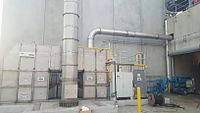
Photo from wikipedia
Abstract Iran is a wide country with a variety of climates. In the summer, the temperature of the northern part of the country could reach up to about 50 °C at… Click to show full abstract
Abstract Iran is a wide country with a variety of climates. In the summer, the temperature of the northern part of the country could reach up to about 50 °C at an extremely high humidity, which makes the use of evaporative cooling inappropriate. The existing solution is the use of standalone compression chillers at all the households. This puts much pressure on the electrical grid and massively costs the government to pay a considerable portion of the electricity bills of people as subsidy. This study proposes the implementation of district cooling systems in the northern part of Iran to address this challenge and presents a thorough techno-economic feasibility analysis of this proposal. For this, an arbitrary pattern for a small case study is manipulated, and all the thermodynamic simulations are carried out. The technical and economic results are then compared with those associated with the existing cold supply method. The results show that the development of district cooling systems with large-scale absorption chillers driven by fire-tube boilers can totally solve the electricity supply problem of this area. In addition, the economic analysis, based on the net present value method, reveals that the payback period can be as short as 6 years.
Journal Title: Energy
Year Published: 2021
Link to full text (if available)
Share on Social Media: Sign Up to like & get
recommendations!